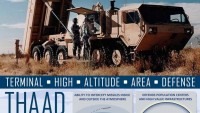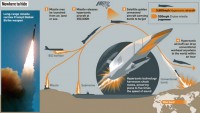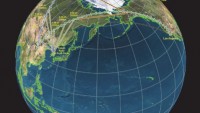China Again Warns of Action Against THAAD; Might go Ahead with Joint Defense with Russia
| Arthur Dominic Villasanta | | Sep 30, 2016 09:52 AM EDT |
(Photo : Raytheon) THAAD's X-band AN/TPY-2 radar system.
China might join Russia in deploying the joint missile shield and land attack missiles to counter the deployment of the United States' Terminal High Altitude Area Defense (THAAD) system to South Korea by late 2017.
In another angry announcement, China yesterday threatened to take unspecified but "necessary action" to ensure THAAD, especially its powerful radars that can see thousands of kilometers into China, doesn't compromise its national security.
Like Us on Facebook
"China has made clear its stance on several occasions with regard to THAAD," said foreign ministry spokesman Geng Shuang.
"Its placement on the Korean Peninsula will not resolve security issues of relevant countries, nor will it help realize denuclearization and maintain peace and stability on the peninsula."
He said the deployment "will hurt strategic and security interests of countries and undermine the strategic balance in the region... China firmly opposes it and we will take necessary measures to maintain the strategic balance," he added.
What infuriates China isn't the THAAD interceptor missiles but the powerful THAAD radar that detect and guide these missiles onto their targets. It believes, and rightly so, these radars will degrade the capabilities of its intercontinental ballistic missiles (ICBMs) aimed at the continental United States (CONUS).
The radar used by THAAD is the X-band AN/TPY-2. This has two configurations: a Terminal Mode with a range of 600 km and a Forward-Based Mode whose exact range remains secret but might be anywhere from 1,500 km to 3,000 km, according to experts.
China is worried THAAD's radar might provide early tracking data to the U.S. ballistic missile defense system, especially the Ground Based Interceptors responsible for defending CONUS, thereby degrading China's ability to hit the United States with its nuclear warhead ICBMs.
One of THAAD's missions is strengthening U.S. defenses against North Korean ballistic missile attack on CONUS.
Last July, China and Russia said they planned to establish a joint missile warning system to neutralize what they see as national security threats stemming from THAAD's radar coverage.
Russia argues the detection abilities of THAAD's radar will allow the U.S. to spy on Russian and Chinese ballistic and aerodynamic targets up to 1,500 kilometers away. From South Korea, the Americans can peer into the Russian territory and China's, as well, said the Russians.
An appropriate response to THAAD "could be the creation of a unified system of Russia and China, a sort of missile defense system," said military expert and Deputy Director of Institute of CIS countries, Vladimir Yevseyev.
China claimed THAAD would destabilize the regional security balance without achieving anything to end North Korea's nuclear program.
"The Chinese side will consider taking necessary steps to maintain national strategic security and regional strategic balance," warned China's Ministry of National Defense in June.
Tagschina, Russia, THAAD, Terminal High Altitude Area Defense, South Korea, United States, AN/TPY-2
©2015 Chinatopix All rights reserved. Do not reproduce without permission
EDITOR'S PICKS
-

Did the Trump administration just announce plans for a trade war with ‘hostile’ China and Russia?
-

US Senate passes Taiwan travel bill slammed by China
-

As Yan Sihong’s family grieves, here are other Chinese students who went missing abroad. Some have never been found
-

Beijing blasts Western critics who ‘smear China’ with the term sharp power
-

China Envoy Seeks to Defuse Tensions With U.S. as a Trade War Brews
-

Singapore's Deputy PM Provides Bitcoin Vote of Confidence Amid China's Blanket Bans
-

China warns investors over risks in overseas virtual currency trading
-

Chinese government most trustworthy: survey
-

Kashima Antlers On Course For Back-To-Back Titles
MOST POPULAR
LATEST NEWS
Zhou Yongkang: China's Former Security Chief Sentenced to Life in Prison

China's former Chief of the Ministry of Public Security, Zhou Yongkang, has been given a life sentence after he was found guilty of abusing his office, bribery and deliberately ... Full Article
TRENDING STORY

China Pork Prices Expected to Stabilize As The Supplies Recover

Elephone P9000 Smartphone is now on Sale on Amazon India

There's a Big Chance Cliffhangers Won't Still Be Resolved When Grey's Anatomy Season 13 Returns

Supreme Court Ruled on Samsung vs Apple Dispute for Patent Infringement

Microsoft Surface Pro 5 Rumors and Release Date: What is the Latest?














